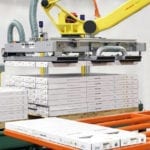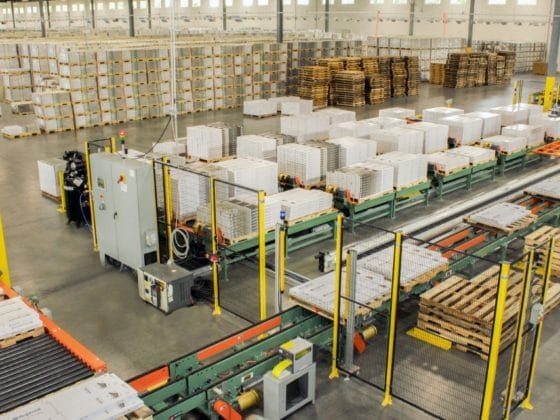Robotic Mixed Pallet Building Systems by MESH Automation
A robotic mixed pallet building system or mixed load palletizer is where multiple SKU’s are robotically palletized on a single pallet or single unit load. The load can be configured with one SKU per layer (aka Rainbow Pallet), mixed SKU’s on each layer with the same size (height) container/case or a randomly mixed SKU pallet with each SKU having a different size container/case.
For Rainbow Pallets, MESH has delivered several systems (using their MACPalOF system) that utilize our unique robot transfer unit with built in WIP rack and zoned end of arm tool for optimizing the robot motion and keeping the cycle rate at the best available.
Multiple Random SKU palletizers need to utilize special sensors and AI driven software. At MESH we have leveraged our robotic system expertise and have partnered with AI software and sensor suppliers to offer our customers robotic mixed pallet building solutions with random SKU introduction.
Benefits of a MESH Robotic Mixed Pallet Building System
For Rainbow pallet building MESH has proven experience with systems in place since 2018. The challenges to these systems mainly reside in the floor space needed and cycle rate. With our proven designs MESH can confidently predict the throughput and provide actual dimensional drawings. The benefits are significant for your operation.
- Rainbow pallet building systems will likely increase production rates, improve labor utilization, improve job conditions (better ergonomics, less forklift interaction…) reduce product waste and improve product and package quality.
- Fewer risks of product damage because of the accuracy and control over the acceleration and deceleration of the product through the use of robotics.
- Ability to further your ROI by introducing post pallet building automation through automatic transfer to a stretchwrapper, labeler and AMR or AGV transport to your warehouse.
For Random SKU pallet building MESH, with our partners, can claim hundreds of applications running. This wealth of experience is what you need for your system. The library of container data images and software algorithms that have been fine tuned over years of use is what makes these systems run well with predictable throughput. The same benefits described above for rainbow pallets apply here as well.
Capabilities of a MESH Robotic Mixed Pallet Building System
- Doner pallet locations can number up to four for a stationary robot. Robot on a rail can handle many more with ten being a common number.
- Random SKU pallet building typically takes containers/cases from a single conveyor line or a sorter with up to four lanes per robot and builds the pallet(s).
- Cases per minute speed is usually forefront of most specifications. It is best to consult with MESH sales and applications engineers to understand the productivity needs and options available.
- Pallet stack height – Most modern depalletizing robots if configured correctly can stack pallets up to 108” tall.
- Pallet or stack envelope (length and width) – Most stacking configurations are designed to fit into a 48” x 40” envelope, but robots are very flexible and can easily accommodate most requirements within reason.
- Dunnage – MESH can incorporate slip sheet at the bottom of the load and or within layers on a rainbow pallet. Random SKU pallets can typically only have a slip sheet on the bottom. Corner boards would be applied during stretchwrapping.
- Safety – MESH designs our robotic case depalletizers to RIA standards and will complete a risk assessment of the entire system. Our MAC control system uses a safety PLC and high-quality guarding and interlock switches that match the risk assessment’s requirements for modern equipment needs in North America, Asia, or Europe.
Mixed Case Palletizing FAQ
Are the new sensor and AI technologies reliable?
MESH has partnered with suppliers that have hundreds of systems in operation around the world. While there are limits to any technology, after evaluation, MESH will point out any areas of concern.
Can the system handle taped or glued boxes?
Yes, our system can handle both taped and glued boxes on the top and bottom.
How much space does a typical system take up?
MESH has pre-engineered systems that can be as small as 60” x 144”. The size of the systems can vary and get much larger depending on the number of build stations required.




































